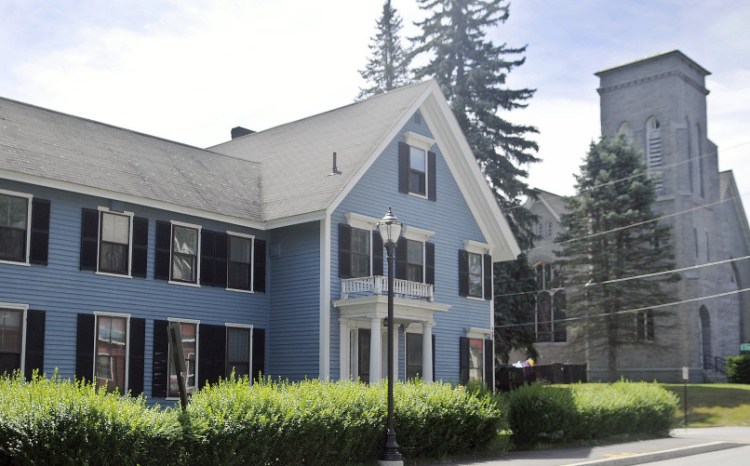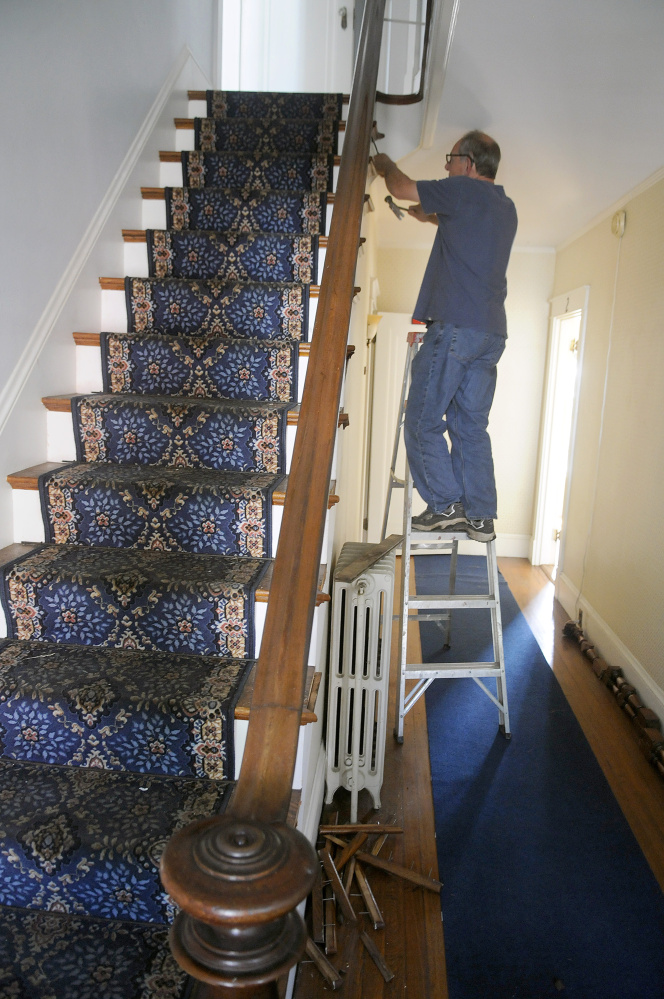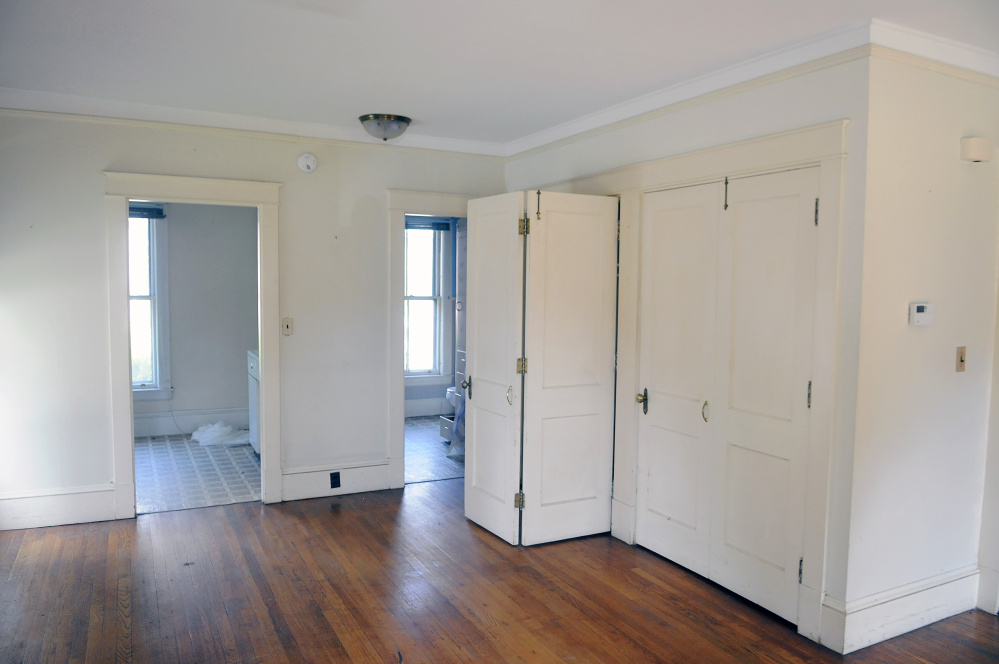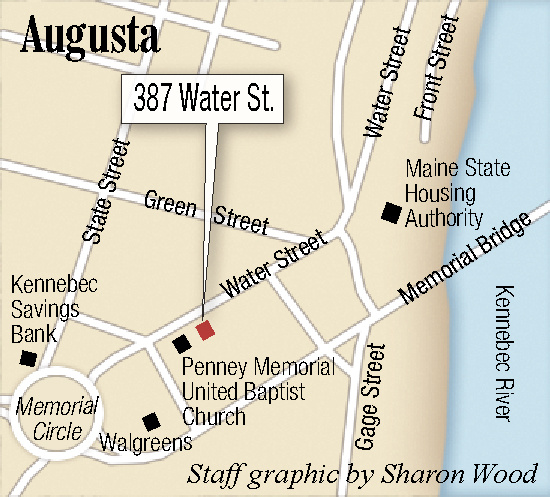AUGUSTA — A Water street apartment building deemed historically significant by the city’s Historic Preservation Commission is scheduled to be demolished by its new owner, Penney Memorial Baptist Church.
The pending destruction of the 167-year-old building is the latest example of the city failing to preserve its cultural and architectural past, according to one city councilor and commission member.
The 387 Water St. lot will be landscaped and have a plaque noting its historical significance, as the former home of both a late Augusta mayor and a city marshal. But the blue building on the site — built in 1848 and used most recently as a multi-unit apartment building, and by the previous owner as an office for his law practice — is being prepared this week for demolition.
Church officials followed the city’s procedure for demolishing an older building, including waiting more than the 90 days as required by the city’s demolition delay ordinance after the building was determined by the Augusta Historic Preservation Commission to be historically significant. The church plans to tear it down, as well as another, newer building with which it shares a parking lot.
The city’s demolition delay rules, passed in 2012, are aimed at buying time for historically significant buildings to be saved through preservation, instead of being torn down.
Dale McCormick, an at-large city councilor and member of the Augusta Historic Preservation Commission, said the loss of the building is the latest incidence of Augusta losing its “irreplaceable cultural and architectural structures.”
She said the city’s demolition delay ordinance is “toothless” because it doesn’t provide any tools to prevent historic buildings from being demolished, just delays their demolition for 90 days.
“If you look at the places that are thriving in Maine, they’re all preserving their architectural and cultural past, because they understand that is important,” McCormick said. “And we’re not. We just don’t have any tools in Augusta to preserve, or even evaluate preserving. We’re slowly replacing our past with, well, a parking lot, in this case.”
The demolitions will make way for additional parking for the church — up to 300 people attend Sunday services — to provide a buffer between it and the adjacent neighborhood, and give the church control over the property, which is across East Crescent Street from the church and its day care playground.
Daniel Wathen, former Maine chief justice and Penney Memorial Baptist Church’s moderator, said the church bought the vacant building after seeing it remain for sale for a couple of years.
“The church was interested in it as a buffer; it extends your area of control by owning it,” Wathen said Monday. “The church wasn’t interested in rehabilitating the building. It was for sale for some time and there didn’t seem to be much interest in it. So the church acted on the fact that it’d make a buffer and extend our footprint there. And potentially serve as additional parking.”
The home, according to preservation commission meeting minutes, was at different times home to Alden Philbrook, mayor of Augusta in 1883, who was also a deacon in the First Baptist Church in Augusta, the predecessor to Penney Memorial Baptist Church. Joshua Heath, a former city marshal and firefighter, also lived there.
The commission voted unanimously in June — in large part because of the house’s ties to Philbrook and Heath — to deem the property historically significant. That set up a 90-day waiting period before it could be demolished, a threshold that came July 20.
The church has a demolition permit and is expected to proceed with demolition soon, according to City Manager William Bridgeo.
McCormick, the city councilor and commission member, said the city is losing its history, has lost a lot of affordable housing units, and people in the community, other than some downtown property owners, haven’t yet recognized that preserving history helps create economic development.
She said she understands the church has needs it seeks to address by buying and demolishing the building to make way for parking. She said she is upset by the trend in the city of allowing historic buildings to be demolished.
In August 2015, Kennebec Savings Bank had a Chapel Street apartment house torn down to provide better access and parking for the bank. That building, too, had been labeled as historically significant by the preservation commission.
McCormick said the city erred in helping have older buildings demolished to make way for the new Capital Judicial Center, and also hasn’t been taking care of some of its own older property, including a former fire station across from the old Cony flatiron building.
The previous owner of the 387 Water St. building, Charles Priest, whose law offices were located in it, told the commission it had been difficult to find tenants for the building, because it is hard to attract people to that neighborhood. Church officials said it could cost $200,000 to $300,000 to rehabilitate the building, including replacement of windows and doors, roof repair or replacement, chimney repair, heating system replacement, addition of a second means of exit on the second floor, and removal of asbestos in the basement.
Bridgeo said he and Mayor David Rollins met with church representatives twice to discuss possible ways the building might be reused, but they said it was not a viable option because of the building’s deteriorated condition and cost of redeveloping it.
Wathen said the church agreed to put a plaque on the site, commemorating the site and recognizing Philbrook’s and Heath’s contributions to Augusta.
“The building itself, other than being an early building, has no historical significance to it, really,” Wathen said.
A smaller, newer building at 3-5 East Crescent St., which shares a parking lot with the 387 Water St. building, also will be demolished as part of the project. The preservation commission looked at that building, too, but determined it was not potentially of historic significance. It was built in the 1940s.
Wathen said the church is growing and draws 250 to 300 people to Sunday services. He said on Sundays parking isn’t usually much of a problem, as church members can park in nearby lots that aren’t used on weekends. However, he said major events at the church, such as funerals or weddings, taking place during the week can be short on parking as the church’s lot can’t accommodate that many vehicles at once.
The 387 Water St. lot is expected to provide 15 parking spaces. It will be gravel, initially, but may be paved later, Wathen said.
Keith Edwards — 621-5647
Twitter: @kedwardskj
Send questions/comments to the editors.







Success. Please wait for the page to reload. If the page does not reload within 5 seconds, please refresh the page.
Enter your email and password to access comments.
Hi, to comment on stories you must . This profile is in addition to your subscription and website login.
Already have a commenting profile? .
Invalid username/password.
Please check your email to confirm and complete your registration.
Only subscribers are eligible to post comments. Please subscribe or login first for digital access. Here’s why.
Use the form below to reset your password. When you've submitted your account email, we will send an email with a reset code.